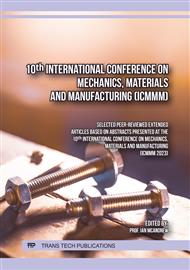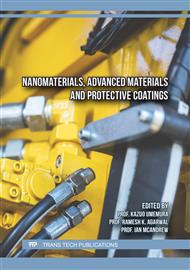[1]
Z. Hashi: J. Appl. Mech. Trans. ASME, 50(3), (1983) p.481–505.
Google Scholar
[2]
Klocke, Fritz, Sein Leung Soo, Bernhard Karpuschewski, John A. Webster, Donka Novovic, Amr Elfizy, Dragos A. Axinte, and Stefan Tönissen: CIRP Annals 64(2), (2015): 581-604.
DOI: 10.1016/j.cirp.2015.05.004
Google Scholar
[3]
J. E. Gray and B. Luan: J. Alloys Compd., vol. 336, (2002), p.88–113.
Google Scholar
[4]
Figueiredo, R. B., and Langdon, T. G.: Journal of materials science, 44(17), (2009), pp.4758-4762.
Google Scholar
[5]
Buha, J.: Journal of Materials Science, 43(4), (2008), pp.1220-1227.
Google Scholar
[6]
Yang, M., Pan, F., Cheng, R., and Tang, A.: Journal of Materials Science, 42(24), (2007), pp.10074-10079.
Google Scholar
[7]
Li, F., Wang, Y., Chen, L., Liu, Z., and Zhou, J.: 40(6), (2005), pp.1529-1531.
Google Scholar
[8]
Fan, J. F., Yang, G. C., Chen, S. L., Xie, H., Wang, M., and Zhou, Y. H.: Journal of materials science, 39(20), (2004), pp.6375-6377.
Google Scholar
[9]
S. Castiglioni, A. Cazzaniga, W. Albisetti, and J. A. M. Maier: Nutrients, vol. 5, (2013), p.3022–3033.
Google Scholar
[10]
S. Graff, W. Brocks, and D. Steglich: Int. J. Plast., 23(12), (2007), p.1957–1978, 2007.
Google Scholar
[11]
A. N. Chamos, S. G. Pantelakis, G. N. Haidemenopoulos, and E. Kamoutsi: Fatigue Fract. Eng. Mater. Struct., 31(9), (2008), p.812–821.
DOI: 10.1111/j.1460-2695.2008.01267.x
Google Scholar
[12]
DIN 50125: 2016‐12: Testing of metallic materials‐Tensile test pieces, (2016).
Google Scholar
[13]
A. Adawi, M. A. Youssef, and M. E. Meshaly: Eng. Struct., vol. 91, (2015), p.1–15.
Google Scholar
[14]
Lv, F., F. Yang, Q. Q. Duan, Y. S. Yang, S. D. Wu, S. X. Li, and Z. F. Zhang: International Journal of Fatigue 33(5), (2011), pp.672-682..
Google Scholar
[15]
Laboratory, The Taylor-Hobson: Journal of Scientific Instruments 4(2), (1926), pp: 55-55.
Google Scholar
[16]
P. D. Bilmes, C. L. Llorente, C. M. Méndez, and C. A. Gervasi: Corros. Sci., 51(4), (2009), p.876–881.
Google Scholar
[17]
C. K. Wu and M. M. Makhlouf: Light Metals 2011, (2011), p.431–840.
Google Scholar
[18]
G. Krauss: Reference Module in Materials Science and Materials Engineering, (2016).
Google Scholar
[19]
S. Z. Bokshteyn: Met. Sci. Heat Treat. Met., vol. 3(11–12), (1961), p.473–480.
DOI: 10.1007/bf00814533
Google Scholar
[20]
A. S. Guimarães and J. C. P. Filho: Scanning, 26(1), (2004), p.62–66.
Google Scholar



